Resources you can trust

Air raid shelters
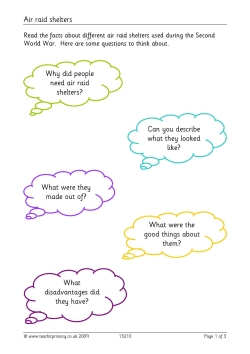
Why did people need air raid shelters? What were they made out of? Children read and discuss facts about World War Two air raid shelters. Can they plan and build their own amazing model shelter? An excellent cross-curricular Design and technology activity.
All reviews
Have you used this resource?
Resources you might like
World War 2 Air Raid Shelters: Facts and Information
Several different types of air raid shelters were used by the people of Britain during the Blitz of World War 2. Some of these shelters made use of structures and underground spaces which already existed, and some of the shelters were constructed from scratch.
Here are some details about some of the different types.
Cellars and Basement
- Cellars were used as very effective underground bomb shelters. Unfortunately, compared to other European countries, very few houses in Britain had cellers – they were only built in large houses and older properties.
- The basements of public buildings such as schools, hospitals, and the basements of businesses were used as shelters during the Blitz. The basements offered underground protection from bombs, but there was the risk of heavy machinery falling on top of the shelter if the site was hit.
Railway Arches and the Underground
- Railway arches, constructed of brick, offered good protection from falling bombs and they were certainly used as air raid shelters in the Blitz. The only problem was that railway lines were sometimes targeted by the Germans in bombing raids.
- The Government was against people sheltering in the Underground tunnels during air raids. They thought that disease would spread (due to the small number of toilets in some stations), people would fall on the tube lines and that people might be tempted to never leave the safety of the tunnels. All of these arguments were proved wrong and Londoners took matters into their own hands by forcing their way into the Underground stations.
- The Government changed its views on this type of shelter and started fitting out Underground stations with bunks, first aid kits and chemical toilets.
- Underground stations were not completely safe as bomb shelters – they were still vulnerable to a direct hit.
- It is estimated that over 170,000 people used the London Underground as an air raid shelter during the Blitz.
Other Tunnels and Caves
Throughout Britain during the Blitz, people were making use of any underground spaces as a means of sheltering from the German bombs. Naturally forming caves and tunnels under castles, palaces and other historical buildings were frequently used.
Street Communal Shelters
- The Government started a a programme of building street communal shelters in March 1940. These shelters were to be constructed by private builders (under the supervision of Government inspectors and surveyors).
- The shelters were built with thick brick walls and a reinforced concrete roof.
- They could house about 50 people.
- Many street communal shelters were built.
- Unfortunately, the shelters didn’t perform very well in air raids. The brick walls were often shaken down allowing the concrete roof to fall on those inside.
- Improved designs were introduced, but public confidence in the communal shelters had been lost.
- The trend moved towards individuals building shelters on their own property with materials supplied by the Government.
Anderson Shelters and Morrison Shelters
- Anderson shelters were designed to house six people.
- They used curved and straight panels of galvanised corrugated steel, and they performed really well in bomb tests.
- Over 3 million Anderson shelters were put up all over Britain. They were free to all families who earned less than £250 a year.
Click the link to find out more facts about Anderson Shelters .
- The Morrison shelter was essentially a reinforced metal dining room table that a family could sleep under during the nighttime air raids.
- It was not designed to offer protection against a direct hit, but it was very effective at sheltering people from bomb blasts and falling debris. One study of bomb damaged houses showed that more than 80% of those sheltering in correctly positioned and constructed Morrison shelters survived without major injury.
Click the link to find out more facts about Morrison Shelters .
If you want to find out more about World War 2 , please visit our WW2 links page.
Leave a Reply Cancel reply
Your email address will not be published. Required fields are marked *
This site uses Akismet to reduce spam. Learn how your comment data is processed .
Amazon Affiliate Disclaimer
Archbishop Courtenay Primary School
- Lesson 4: Air Raids and Anderson Shelters
- Our Learning
- Class Pages Archive: 2019 - 2020
- Goldfinches - Year 6
- History World War II
- History Lessons
Design a leaflet giving advice from the government to someone sheltering during an air-raid. You will need to include information on this presentation and from the text 'What To Do In An Air-raid' (below).
- Anderson-Shelters.pdf
- Anderson-Shelters.pptx
Read the information then answer the questions
(you can download the information as a document if you prefer - scroll down the page)
What to do during an air-raid
During the late 1930s, the British government began to prepare the civilian population for war. As well as the widely expected and feared bombing raids, it was also thought that poison gas might be used against civilians. Gas masks were issued in 1938 and over 44 million had been distributed by the outbreak of the Second World War in September 1939.
From 1 September 1939, 'Blackout' was enforced. Curtains, cardboard and paint were used to prevent light escaping from houses, offices, factories or shops, which might be used by enemy bombers to locate their targets.
The first air raid shelters were distributed in 1938. People without the outside space needed to put one up were encouraged to use communal shelters instead.
Public information films, leaflets and posters provided advice and guidance on how to cope in an air raid. These are some of the ways that the public could protect themselves – and others – during the Blitz .
Take care during an air-raid

Blackout restrictions did not just cover the home. Street lighting and illuminated signs were extinguished and all vehicles had to put caps over their lights to dim them. In the early days of the war, people were forbidden even to carry around torches. The blackout caused a steady rise in accidents. A poll published in January 1940 found that since the previous September, one person in five had been injured in the blackout.
Carry a gas mask

The public were urged by the government to carry their gas masks at all times, although it was not a legal requirement to do so. Initially, there were instances where workplaces sent home any employees who did not have their masks and some places of entertainment refused to allow people to enter without them. During the Phoney War period – from 3 September 1939 to 10 May 1940 – many people stopped carrying their gas masks.
Ta ke shelter at home

An Anderson shelter stands intact amongst a scene of debris in Norwich, c.1941
Anderson shelters – named after Sir John Anderson – consisted of two curved corrugated sheets of steel, bolted together at the top and sunk three feet into the ground, then covered with eighteen inches of earth. If constructed correctly, they could withstand the effects of a hundred-pound bomb falling six feet away. However, many Anderson shelters leaked, were cold, dark and cramped and amplified the noise of falling bombs.
If outside, find a communal shelter

The Tube, October 1940 , by Feliks Topolski (wash on paper)
The government initially tried to prevent London Underground stations being used as air raid shelters, fearing the development of a 'deep shelter mentality' and the potential disruption of the capital's transport network. However, Londoners persisted in using the Tube and eventually the government had to reconsider. Aldwych station was closed and converted into a permanent shelter. Improvements such as bunks, better lighting, washing and toilet facilities were made at other stations.
Shelter at home (even if you don't have a garden)

A Morrison shelter in a dining room, 1941
Morrison shelters – named after the Home Secretary Herbert Morrison – were produced from January 1941. They consisted of a rectangular steel and mesh cage which could accommodate two adults and two children. The Morrison was intended for use indoors so was suitable for those without gardens. Though more popular than Anderson shelters, they were less effective as they provided no lateral protection. They could also be used as a dining table during daytime.
Be prepared for a gas attack

Air Raid Precautions (ARP) gas rattle
Air raid wardens were equipped with gas rattles and whistles to alert the public to a gas attack. Post boxes and lamp posts were painted with a substance which would reveal the presence of gas and identification and decontamination squads were set up. The public could attend lectures on the different types of gases that might be used and were advised to fill gaps in their windows and doors to prevent gas seeping in.
Read the text then answer the questions. Refer to the text in your answer. (Think – where in the text is the answer).
- In the first paragraph we are told ‘the British government began to prepare the civilian population for war’. What is meant by ‘ the civilian population’? [1 mark]
- War was declared on 1 st September 1939. List 2 things that the government did to prepare for war before this date. [1 mark]
- List 3 changes people had to make when the ‘Blackout’ was enforced. [2 marks]
- Look at the image of the poster in the paragraph subtitled ‘Blackout’. Why do you think people were encouraged to wait 15 seconds before moving in the blackout? [2 marks]
- Look at the paragraph with the subheading Carry a gas mask. Which word in the first sentence tells us that the government tried to persuade people to carry a gas mask? [1 mark]
- Why do you think that Anderson shelters were names after Sir John Anderson? [1 mark]
- Some people preferred not to use an Anderson shelter. Why do you think this was? (Refer to the text). [2 marks]
- Why did the government try to prevent people from taking shelter in the underground? [2 marks]
- Explain why Morrison shelters were less effective forms of protection? [1 mark]
- Look at the first heading on page 3. What does communal mean? [1 mark]
- Do you think the government was effective in preparing people for air-raids? Explain your answer making reference to the text. [3 marks]
Information sheet and answer sheet
- What To Do During An Air Raid .pdf
- Air raid text answers.pdf

These posters helped Britain prepare for air-raids
in the Second World War
This will help you to understand how to structure an information text
- how_do_you_survive_an_earthquake.pdf
- how_do_you_survive_an_earthquake.docx
Unfortunately not the ones with chocolate chips.
Our cookies ensure you get the best experience on our website.
Please make your choice!
Some cookies are necessary in order to make this website function correctly. These are set by default and whilst you can block or delete them by changing your browser settings, some functionality such as being able to log in to the website will not work if you do this. The necessary cookies set on this website are as follows:
Website CMS
A 'sessionid' token is required for logging in to the website and a 'crfstoken' token is used to prevent cross site request forgery. An 'alertDismissed' token is used to prevent certain alerts from re-appearing if they have been dismissed. An 'awsUploads' object is used to facilitate file uploads.
We use Matomo cookies to improve the website performance by capturing information such as browser and device types. The data from this cookie is anonymised.
Cookies are used to help distinguish between humans and bots on contact forms on this website.
Cookie notice
A cookie is used to store your cookie preferences for this website.
Air Raid Shelters: A short history of British air-raid shelters WW1 and WW2

From London in 1915 to Gaza in 2009, the aerial bombing of cities has been a central feature of modern industrialised warfare. Gabriel Moshenska of University College London has been studying the drive to build air-raid shelters in 1930s Britain. He finds that the grim experience of the Spanish Civil War was a dominant influence.
Alongside St Paul’s Cathedral, Winston Churchill, evacuees, and gas masks, civilian air-raid shelters are amongst the most familiar images of the Second World War in Britain. In the art and literature of the Home Front, the air-raid shelter and its inhabitants – frightened, dazed, defiant – feature prominently. Bill Brandt’s photographs of Londoners crowded on the platforms of underground stations are echoed in Henry Moore’s sketches and the novels of Elizabeth Bowen, Graham Greene, and others.
The Anderson shelter and the crowded underground-station platform are icons of British Civil Defence. But those images of shelters and shelterers represent a thread connecting civilians caught up in conflicts across time and space from First World War London to Civil War Barcelona, Second World War Tokyo and Hamburg, and on to Hanoi, Beirut, Baghdad, and Gaza.
The First World War
The first bombs fell from an aircraft in 1911, when the Italian military bombarded Ottoman troops in Libya with hand grenades during the Italian-Turkish war of 1911-1912. Four years’ later, the Zeppelins of the German Army and Navy were targeting British cities with bombs weighing up to half a ton.
At the outbreak of the First World War, virtually all combatant nations possessed military aircraft. By the armistice four years later, a distinctive category of bomber aircraft had emerged, including the Russian Ilya Murometz , the Italian Caproni , the French Breguet 14 , the German Gotha and Giant , and the British Handley-Page . By the end of the war, bombs had fallen on Antwerp, London, Felixstowe, Ludwigshafen, Constantinople, and many other European cities.
The British public’s very reasonable response to the growing number and severity of air raids from 1915 onwards was to take shelter. The scientist J B S Haldane reported that in London as many as 300,000 went into underground stations, while another 500,000 slept in cellars and basements. Railway viaducts such as the Tilbury Arches in Stepney were also popular refuges, although the protection offered is doubtful. In Ramsgate, caves and tunnels in the chalk cliffs were employed as shelters for several thousand people. All such shelters would be reused in the Second World War.
The oldest surviving air-raid shelter in Britain is a little grey garage behind a house in Cleethorpes, Lincolnshire. After Zeppelin attacks killed a number of residents and soldiers in April 1916, Joseph Forrester, a chemist and local councillor, constructed a reinforced concrete air-raid shelter with walls half a metre thick. The structure is 4m wide and 5m deep, and consists of a single room with two entrance lobbies. At some point, it was turned into a garage, and as such it survives as a strikingly modern-looking remnant of the first strategic bombing campaign in history.
Barcelona during the Spanish Civil War
It was in the Spanish Civil War of 1936-1939 that the spectre of bombing in Europe grew from a fear into a real threat. The bombing of Guernica and other towns by the German air force raised the possibility of total urban destruction. Italian raids on Barcelona saw a modern, cosmopolitan European city come under attack for the first time since 1918. It was also in Barcelona that the first purpose-built deep bomb-proof shelters were constructed for use by the civilian population.
Following the Fascist military coup and the outbreak of the Civil War in 1936, Barcelona become one of the main strongholds of the Republican Government. When the army garrison attempted to impose military rule, it was defeated in combat by the local anarchist militias. From late 1937, Barcelona functioned as the Republican capital.
The city was bombed heavily during the war, beginning with bombardment from the sea by an Italian cruiser in February 1937. A total of 194 bombing attacks were made on Barcelona, the majority by the Italian air force from its base in Majorca. Around 1,500 buildings were destroyed and 2,500 people killed.
In response, in 1936, the Government of Barcelona formed the Anti-Aircraft Passive Defence Department to coordinate the provision of air-raid protection. Shelter building began immediately, with the aim of cutting 25 tunnel shelters into the bedrock. Following the first bombings, a booklet was produced with instructions for building your own shelter, and various community groups and residents’ associations began to dig shelters around the city. In addition to the 30 shelters eventually built by the city authorities, more than 1,300 shelters of assorted sizes and shapes were built by the general population.
These shelters were cut into the soft sandstone bedrock beneath city squares, empty lots, or under streets. Most were built as networks of tunnels with arched roofs lined with elaborate brickwork, in the local Catalan style. The shelters were fitted with benches, and most had toilets, a dispensary, and electric lighting run off the mains or rechargeable batteries.
Use of the shelters was not universally popular. Some found them unpleasant or claustrophobic, and there were widespread doubts as to their effectiveness. Through 1938, the numbers using the shelters fell.
Because of the wide range of building methods, many of the shelters were not fully bomb-proof, and the introduction of new aircraft and larger bombs by the Italian and German air forces increased the danger.
The bombing continued until Barcelona fell to the Fascists in January 1939. Following the occupation, many air-raid shelters were enlarged and reinforced, as Fascist leader Franco feared that the Second World War might spread into Spain. In the event, this did not happen, and the air-raid shelters of Barcelona were sealed up and forgotten or turned to other uses.
The lessons of Spain
The civil defence of Barcelona was watched keenly across Europe. The scientist J B S Haldane visited Barcelona a number of times during the Civil War and observed the construction of shelters in the city. His book ARP , published by the Left Book Club in 1938, attempted to bring the lessons of Barcelona to the attention of the British public and politicians. Haldane describes a visit to a shelter under construction in Barcelona:
There were four entrances which led down by ramps with a few steps to the tunnels. The ramps twisted repeatedly, until a depth of about 55 feet below the ground was reached. Here began a labyrinth of passages about 7 feet high by 4 feet broad. They were cut in the very tough soil of the district, and had no lining, and I think no supports such as pit props. They were, however, being lined with tiles with a cement backing so at to give a semicircular arch and vertical walls.
Haldane noted the low cost of the shelters and the use of volunteer labour in their construction. He also described other shelters in the city, including an experimental model using two concrete roofs separated by an air space to absorb blast.
A number of British civil engineers travelled to Spain to study the effects of bombing on cities. Francis Skinner worked with Haldane on the brick-lined tunnels described above, while Cyril Helsby visited Barcelona on a trip sponsored by the Labour Party. His study of bomb damage on residential buildings in Barcelona includes a number of detailed plans of surface shelters and shallow, semi-sunken shelters.
Like Haldane, Helsby returned to Britain with a great admiration for the level of protection provided by the Barcelona shelters, especially compared to the meagre British provision at the time. Helsby’s research was presented to the Institution of Structural Engineers, and was debated by a number of prominent scientists and politicians, many of whom were persuaded of the need to become ‘Barcelona-minded’.
Helsby’s work influenced the Labour Party, but, like Haldane’s work and also reports by distinguished engineers such as Ove Arup, it was rejected by the official Hailey Report on air-raid protection. By the outbreak of the Second World War, many of the hard-earned lessons of Barcelona were being acted on in Britain – but not all.
The Second World War
The most common and well-known British air-raid shelter of the Second World War is the Anderson shelter. By the start of 1939, more than a million of these part-sunken shelters, named after the politician responsible for ARP, had been installed in private gardens. Built of curved sheets of steel, they held four to six people each, and were given free to low-income families. By the time the Blitz began in earnest, more than 2.25 million families had Anderson shelters in their gardens.
The Andersons, however, were cold, damp, and frequently flooded. Many people preferred the communal shelters that began to be built in parks, on pavements, and at other open public spaces. The result was a great variety of forms, capacities, locations, and levels of protection. Broadly, four main types can be identified: surface, semi-sunken, sunken, and deep.
Surface shelters
Surface shelters were often simply long brick-and-concrete structures built on pavements or beside buildings. They had one or two entrances, and offered shelter from collapsing buildings and shrapnel. Some could hold several hundred people in varying levels of comfort. They were not particularly blast-proof, however, as many models were badly constructed, often using sub-standard mortar, and were liable to collapse. Other surface shelters were constructed from prefabricated reinforced-concrete units, and a few more bunker-like ones were cast in situ using shuttering.
The Civil Defence Act 1939 declared that: ‘To lessen the number of casualties from a direct hit, the unit size of shelters should preferably be limited to parties of not more than 50 persons’. From then on, this became the common size for surface and semi-sunken air-raid shelters in schools, businesses, and public areas. Most were formed from pre-cast concrete panels or segments, and could be built to a number of sizes and specifications.
Semi-sunken shelters
Semi-sunken shelters such as the Anderson used shallow initial excavation combined with earth banking to increase the strength and blast-resistance of the structure. One of the most common semi-sunken shelters used preformed segments with a curved roof, which could be more easily buried.
As with surface shelters, semi-sunken shelters tended to have their entrances at an angle or behind a wall to protect the occupants from blast, while lowering the risk of being trapped behind a blocked doorway. However, as Helsby had noted in Barcelona, ‘Before they had actual experience of air raid, the people of Barcelona imagined that open trenches or lightly covered shelters would be proof against bombing. They have learnt better now.’ Once again, the hard-earned lessons of Barcelona were squandered by British policy-makers.
Sunken shelters
Sunken shelters often started out as basements or trenches. Basements and cellars were reinforced with planks and girders at various angles so that they could withstand the collapse of the building above. Trenches were dug on open pieces of land and reinforced with sandbags, sheet metal, and wooden props. These were intended both as shelters from bombing or strafing and subsequently to prevent gliders from landing. Later on, many of these trenches were built up with steel, concrete panels, or cast concrete, to create more stable and better protected shelters that could survive bombs exploding underground close by, as well as providing more comfortable accommodation.
Deep shelters
None of the shelters described above was capable of surviving a direct hit. Rather, they were designed to protect against the statistically far higher possibility of a near miss, with its risk of flying bomb fragments and collapsing debris. In the pre-war period, however, there was a widespread campaign for the construction of deep underground shelters that could survive direct hits from heavy bombs.
Following media reports of shelters in Barcelona, many people regarded the government’s air-raid precautions as woefully, even criminally, inadequate, particularly in regard to large, densely-populated urban areas. The Communist Party conducted a spirited campaign in favour of deep shelters for the working class districts around industrial centres likely to be targeted by the bombers.
Finsbury Borough Council commissioned the civil engineer Ove Arup to study the effects of bombing on soil and buried structures, and to design a range of giant bomb-proof shelters. Arup’s designs are bizarre and beautiful, resembling complex molecules, giant spirals, honeycombs, and enormous subterranean multi-storey car-parks. The smallest held 50 people, but the largest was designed to hold 12,300 in bomb-proof safety below many metres of earth and reinforced concrete.
In the event, few of the giant deep shelters were constructed, and none for civilian purposes. Instead, the public began to use the underground stations in London as unofficial shelters. Unlike Andersons and communal shelters, the tube was dry, warm, and apparently bomb-proof. While the authorities initially banned the use of the tube in fear of transport disruption, they soon relented in the face of massive public demand. Not all tube stations were sufficiently deep, however, and bombings at Balham and Bank killed several hundred people.
Remembering everyday life in the shelters
Today, many of the wartime generation can remember their experiences of different types of shelter: the damp and cramped Anderson, the bleak and unhygienic public shelters, and the novelty of school shelters where shrapnel, gossip, and exam answers could be surreptitiously exchanged. Many also recall the attempts by parents and teachers to make shelters into a more familiar, domestic space, with amenities, decorations, and stoves for brewing tea.
The history of air raid shelters in pre-war and wartime Britain is a gripping story of engineering genius and political short-sightedness, and also a story about the men, women, and children who inhabited and endured them.
This article appeared in issue 2 of the magazine, as part of a special feature on the Blitz. Subscribe to Military History Matters and you’ll get cutting-edge analysis and the latest research from world-renowned historians delivered to your door every month – click here for more information.
Thank you for the information about air raid shelters. I think there might be two of them near to where I live and by the canal. If that is what they are they are covered in nature, stinging nettles, weeds etc and have been for at least forty years. That is as far back as I can remember the bit of land.
Hi. Unfortunately I am unable to attach photos of my air raid shelter but will happily do so if you are interested.
We live in Canterbury, our house was built in 1937 at a cost of £750. It was occupied by a couple, their maid and the family cat, the couple were apparently local wine merchants. Sometime around 1939 the family decided to build, at a cost of £375 an air raid shelter in the back garden. There is evidence that some of the structure was prefabricated and some cast on site. It’s an all concrete shelter, the roof is probably 18” thick, with a tar finish, there is a concrete entrance and a buried concrete(?) emergency exit stairway. There are three sections, an entrance lobby at one end and a toilet area at the other, both about 6’x6’x7’ the main area is about 12’x6’x7’ with original wooden storage seating, the sections are separated by steel reinforced concrete doors, it is dry and recently refurbished and rewired. I have tried researching this type of shelter but drawn a blank. If you would like more information or photos please do not hesitate to contact me, if you have any information regarding this type of shelter I would be interested to see it. Kind regards Tony
Leave a Reply Cancel reply
Your email address will not be published.
History for Kids
Anderson Shelter Facts & Information for Kids
What is an anderson shelter.
The Anderson shelter was an air raid shelter designed to accommodate up to six people. It was designed in 1938 by William Paterson and Oscar Carl (Karl) Kerrison in response to a request from the Home Office.
The Anderson shelter was named after Sir John Anderson, who was Lord Privy Seal with the responsibility of preparing air-raid precautions immediately prior to the outbreak of World War II.
Interesting Facts About Anderson Shelter
Below are some interesting facts and information on this very important air raid shelter.
- In 1938 the British Prime Minister Neville Chamberlain placed Sir John Anderson in charge of air raid precautions. Anderson worked with an engineer called William Patterson to design and ball a small, inexpensive air raid shelter that people could build in their garden.
- The first Anderson shelter was built in 1939. It was built in a garden in Islington, London on February 25, 1939.
- Over 1.5 million Anderson shelters were given out before the start of WW2. They were distributed between February 1939 and the start of the Second World War that September. The shelters were given to people in areas that were at risk of being bombed by the Germans.
- Over the course of World War 2, another 2.1 million Anderson shelters were built in gardens around the country.
- Anderson shelters were free for people who earned less than £250 per year. For those with a higher income, they could be bought for £7.
- The shelters were very easy to build. Anderson shelters were made from six corrugated steel panels that were curved and bolted together at the top.
- The Anderson shelters were buried up to a meter in the ground. They would also have a thick layer of soil and turf on top to keep them secure.
- Shelters could hold up to six people and were incredibly strong. The corrugated sheets made them extra strong against compressive force and was perfect for protecting from nearby bomb explosions.
- You had to assemble your own shelter. Families who received an Anderson shelter got the materials and an instruction guide to put it together themselves.
- Many Anderson shelters are still in use today. A lot of people dug up the old shelters when the war ended to use them as garden sheds.
- A lot of Anderson shelters were decorated by their owners. This could include growing flowers or vegetables on the roof.
- UK bombings on German cities killed about 500,000 people but because of Anderson shelters German bombs killed 90% less — around 50,000. This shows just how effective the Anderson shelters were.
- Only 27% of people in London used Anderson shelters according to a 1940 survey. 9% slept in public shelters and 4% slept in underground railway stations. 60% of people were on duty at night or just slept in their own homes.
Read more World War Two Facts
- International
- Schools directory
- Resources Jobs Schools directory News Search

WW2 Air Raid Shelters comparison activity
Subject: History
Age range: 7-11
Resource type: Worksheet/Activity
Last updated
12 January 2020
- Share through email
- Share through twitter
- Share through linkedin
- Share through facebook
- Share through pinterest

A table for comparing Anderson shelters, Morrison shelters and Public shelters like London Underground stations. A great task to set for homework (research can easily be done on the Primary Homework Help page on WW2 shelters).
Tes paid licence How can I reuse this?
Your rating is required to reflect your happiness.
It's good to leave some feedback.
Something went wrong, please try again later.
This resource hasn't been reviewed yet
To ensure quality for our reviews, only customers who have purchased this resource can review it
Report this resource to let us know if it violates our terms and conditions. Our customer service team will review your report and will be in touch.
Not quite what you were looking for? Search by keyword to find the right resource:
- Bahasa Indonesia
- Slovenščina
- Science & Tech
- Russian Kitchen
What went down in the Moscow Metro during WWII? (PHOTOS)
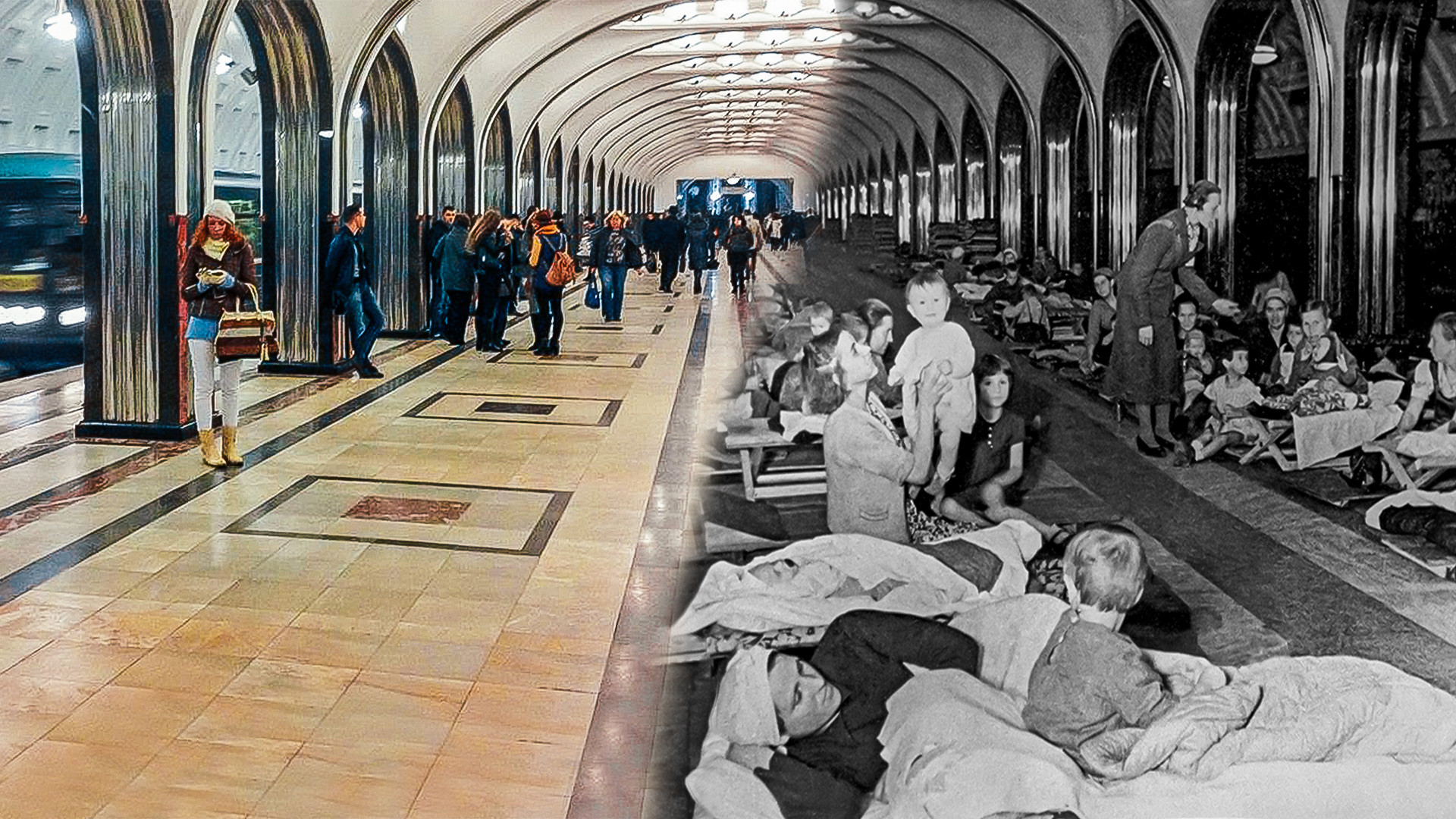
By the time World War II reached the Soviet Union in 1941, Moscow had built three metro lines with a total of 21 stations. During the war, the metro transported passengers by day and then turned into a bomb shelter at night. During bombing raids in 1941, it provided shelter to a total of 13.9 million people. In 1942, when air raids were less frequent, that number dropped to 303,000 people. The last shell fell on Moscow in June 1943, but the metro retained its status as a bomb shelter until the very end of the war.
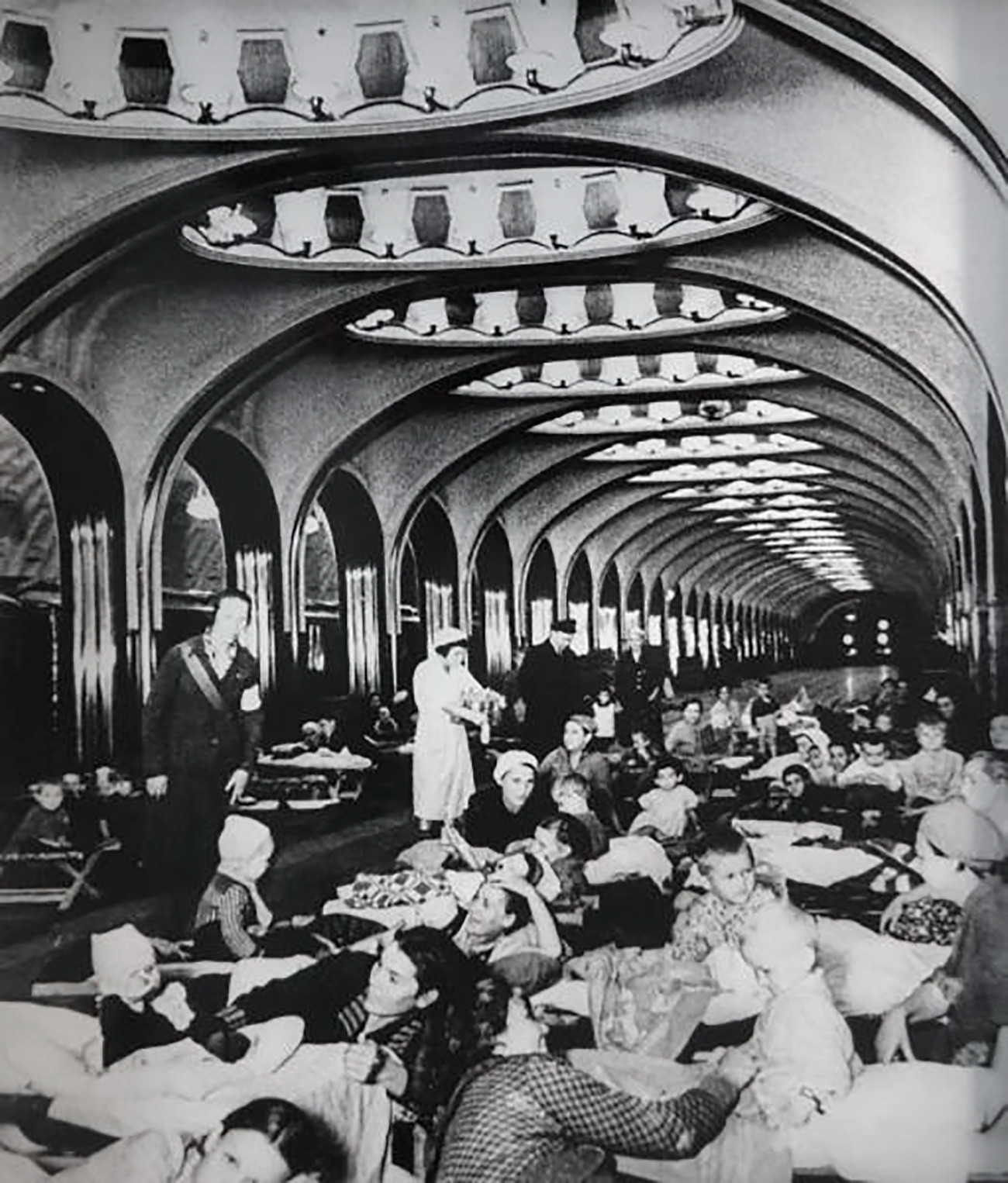
Mayakovskaya, 1941.
The first air-raid signal sounded in Moscow a month after the start of the war on July 22, 1941. Some 500,000 people hid in its stations and tunnels at the time. Another air raid took place the following night. One of the shells damaged the tunnel between Smolenskaya and Arbatskaya stations, another hit the overpass of a metro bridge and a third exploded at the entrance to the Arbatskaya station. Dozens of people were killed, including in stampedes at the entrance to the stations. After this, rules for using the metro as a bomb shelter were developed.
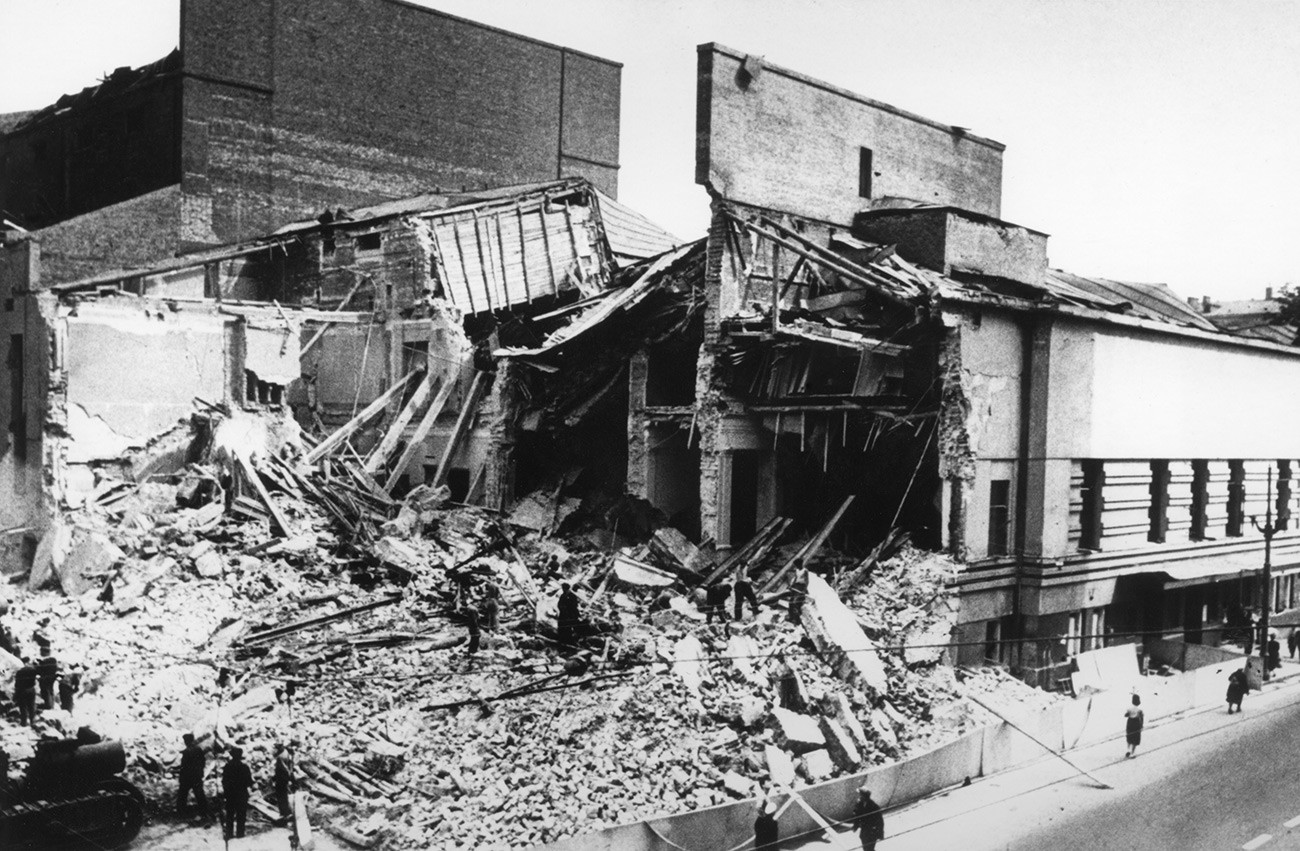
The theater on Arbat street, destroyed on July 1941.
During the war, the metro worked until 10:00 p.m. and then functioned as a shelter until 5:00 a.m. In the event of an air raid, trains stopped running immediately and metro personnel prepared to receive people. Moscow suffered its worst bombing in October and November 1941. During this period, trains stopped running between 5:00 and 7:00 p.m. and then Muscovites settled in for the night in metro coaches, at the stations and in tunnels.
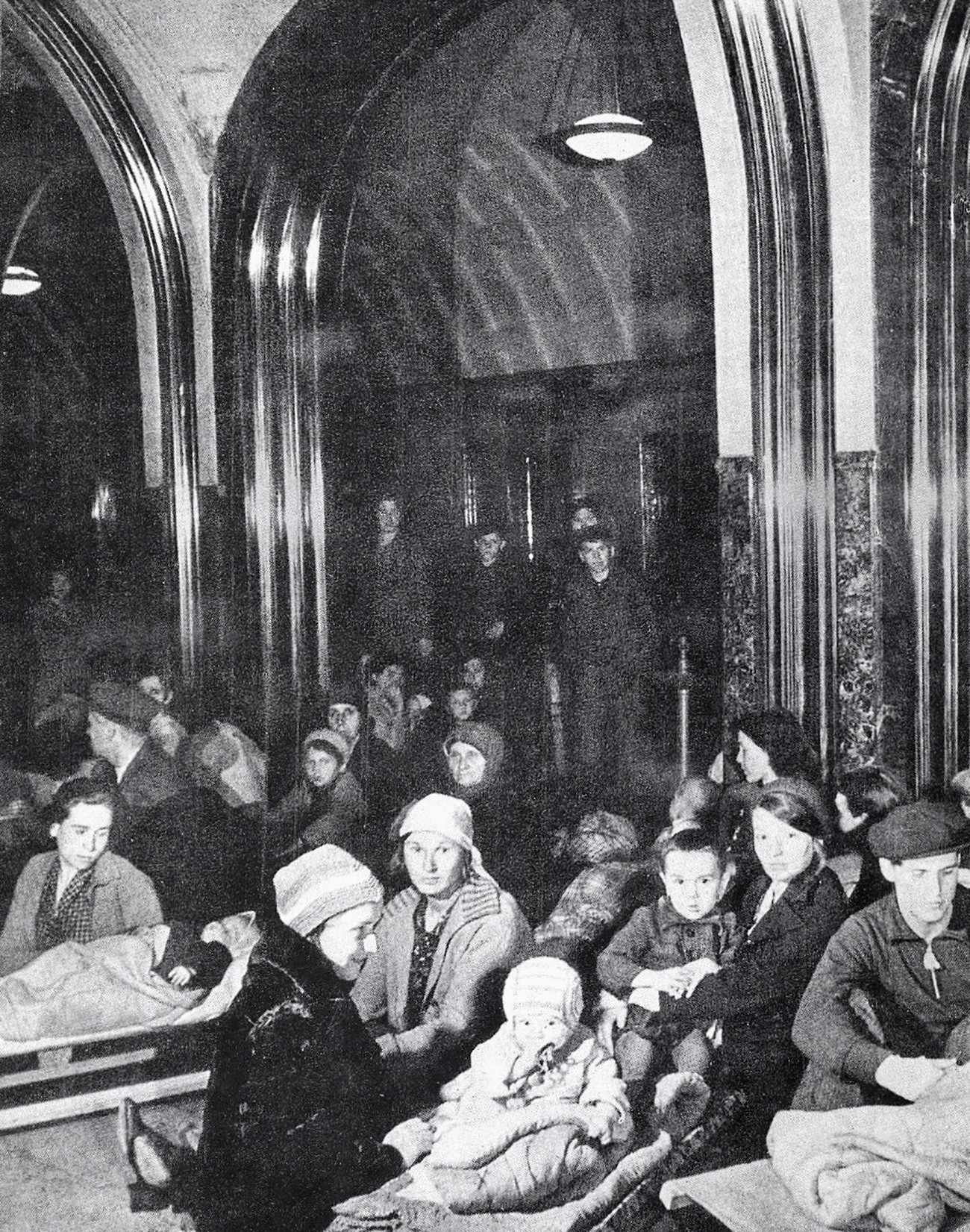
Mayakovskaya station.
According to the archives of the Moscow Metro, a total of 3,800 cribs and 4,600 beds for adults were installed at the stations. Drinking fountains and water taps were installed on the platforms, along with 25 toilets. Doctors were on duty at the stations at all time. In the evenings, children were given milk and white bread. In addition, some stations even organized movie screenings.
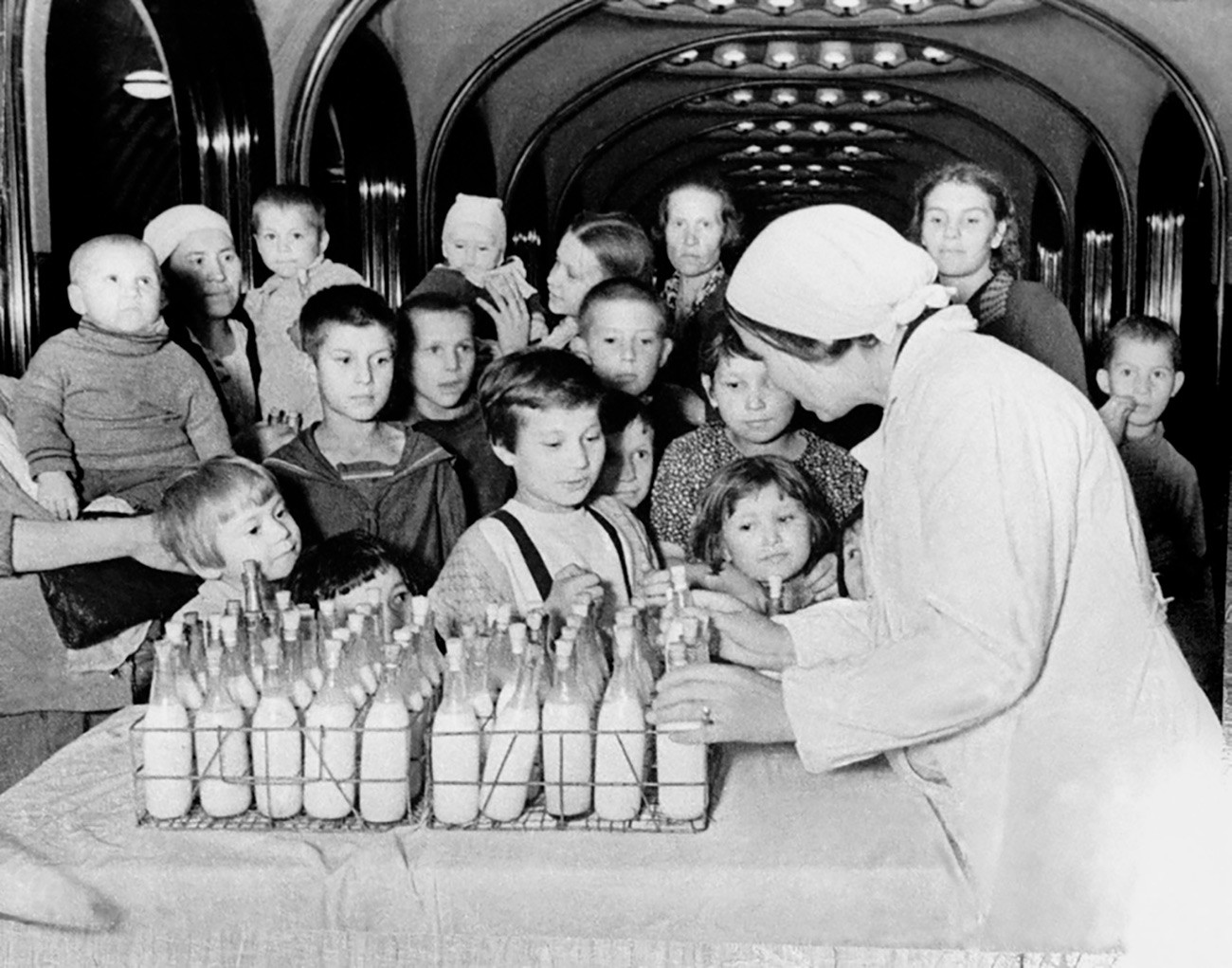
Milk for children, Mayakovskaya station.
In November 1941, a branch of the History Library was set up at Kurskaya station. “I visit it almost daily,” one of its patrons wrote . “Not because my journey home runs through this station, but because I come to read newspapers and other literature...The only drawback that cannot be eliminated is the circulating air from the movement of trains and a continuous stream of passengers.”

A library at the Kurskaya station.
The Chistye Prudy station (then called Kirovskaya) was closed to passengers and converted into a space for the General Staff. At the beginning of the war, the operational command, headed by Joseph Stalin, was based in a house near the entrance to the station, from which one could take an elevator to the underground complex of the command post and cross over into the station.
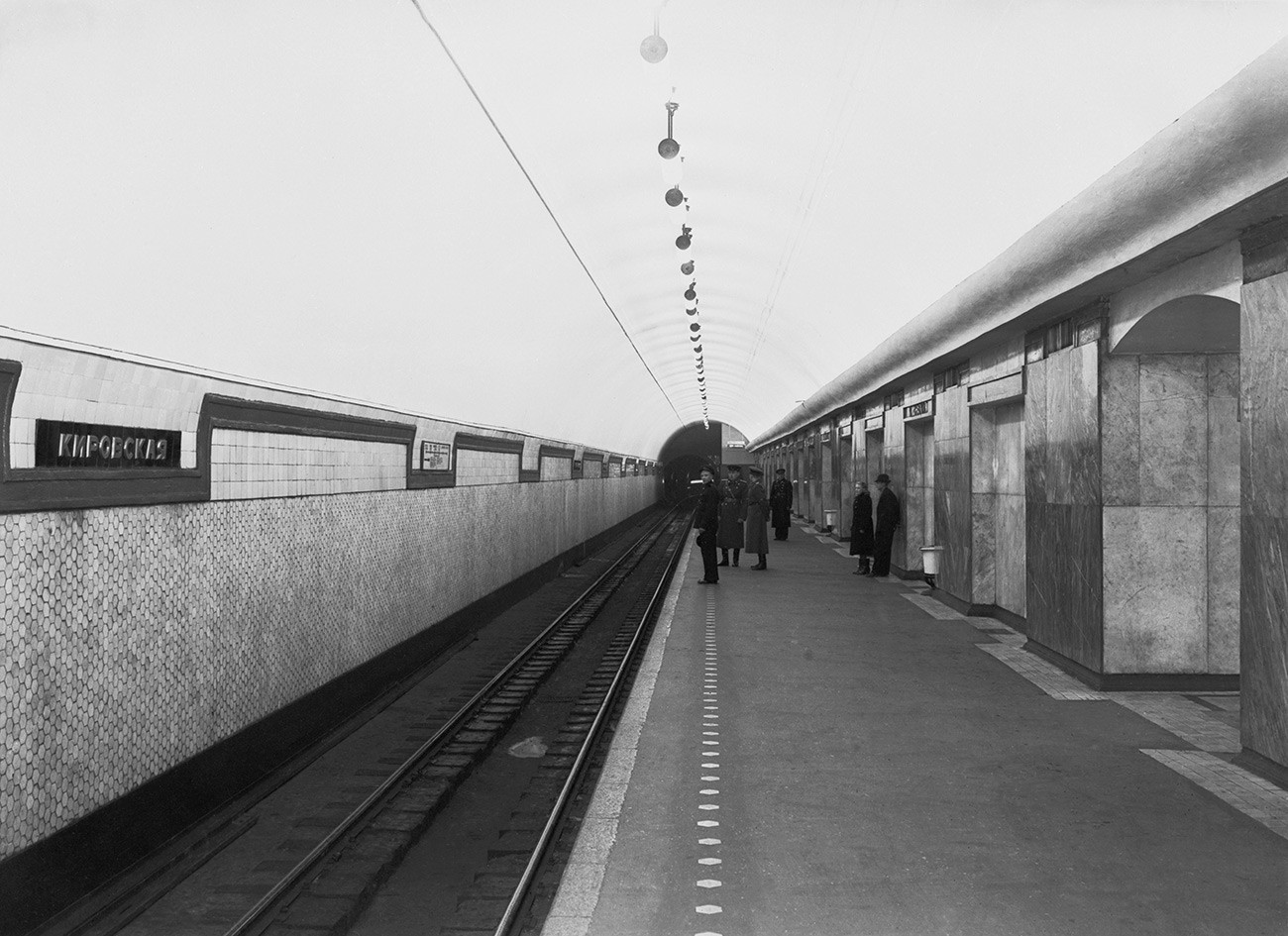
Kirovskaya (Chistye Prudy).
A plywood partition shielded the platform from passing trains, and a reinforced concrete wall was placed in front of the escalators to extinguish a blast wave in the event of a direct hit by an air bomb. The other military command posts were located at Krasnye Vorota, Belorusskaya and Ploshchad Sverdlova (now Teatralnaya) stations.
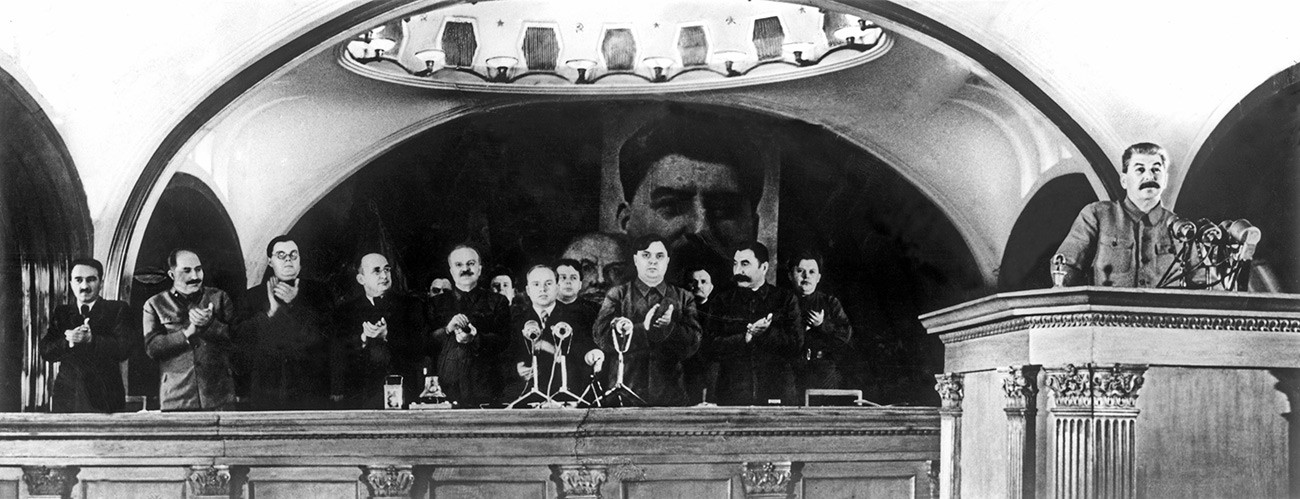
Preparations for the November 7, 1941 celebrations. Joseph Stalin making speech on 24th anniversary of Great October Socialist Revolution at the official sitting of the Moscow City Council. Mayakovskaya, November 6, 1941.
Despite the bombing, the Moscow Metro continued transporting millions of people. The only day in its history when the metro failed to open on time was October 16, 1941. The previous day, the Soviet leadership had decided to destroy the metro and evacuate its trains and other equipment to the rear so as not to surrender it to the enemy. On the night of October 15-16, preparations were under way to flood the station, electric cables were being cut and escalators dismantled. But then in the morning the decision was canceled, and at 6:45 p.m. the metro went back to work. However, some of the equipment was still evacuated to Uzbekistan, leaving only 105 metro coaches in Moscow. If before the war the metro carried 27 million passengers a month, in October 1941 that figure was just 8 million. (Nowadays, the Moscow Metro carries this many passengers in less than a day!)
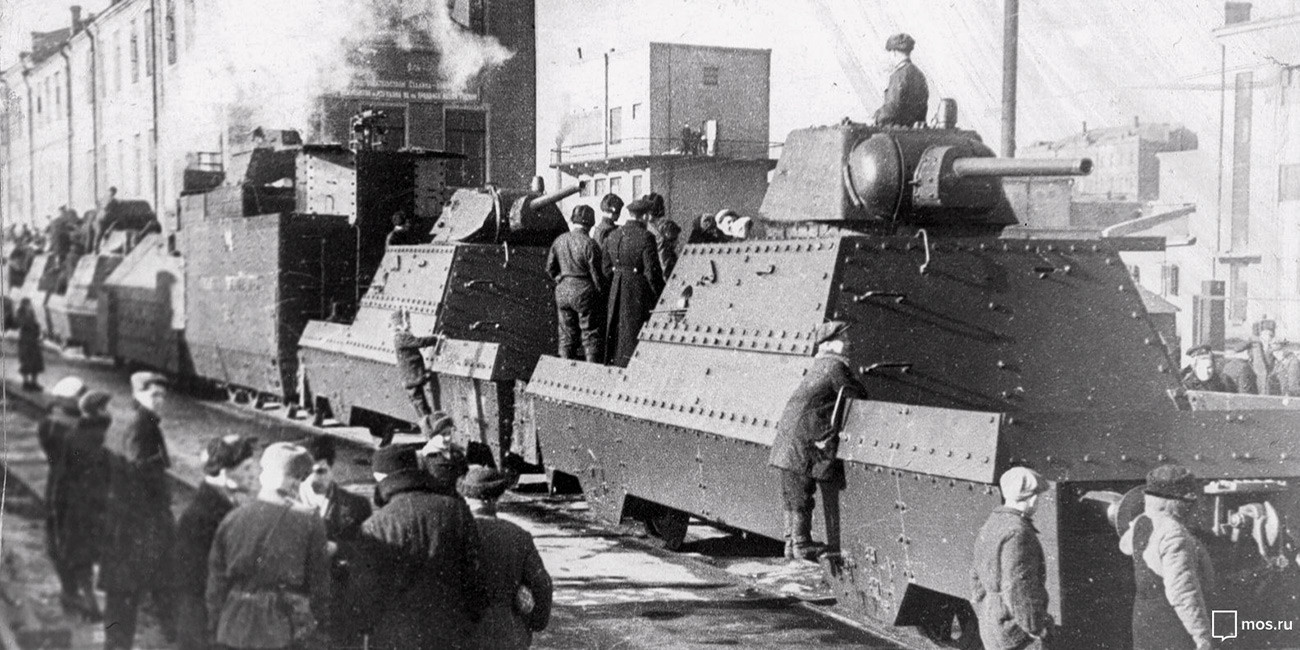
Moscow Metro armored train, 1943. Moscow's archive fund.
During the war, when the majority of men had been conscripted, the metro was staffed mostly by women. The first all-women train, which was run only by female drivers, appeared on March 8, 1942. Women continued to work in the metro after the war too. Some depots—for example, the one at the Sokol station—were used to make bodies for shells and mines.
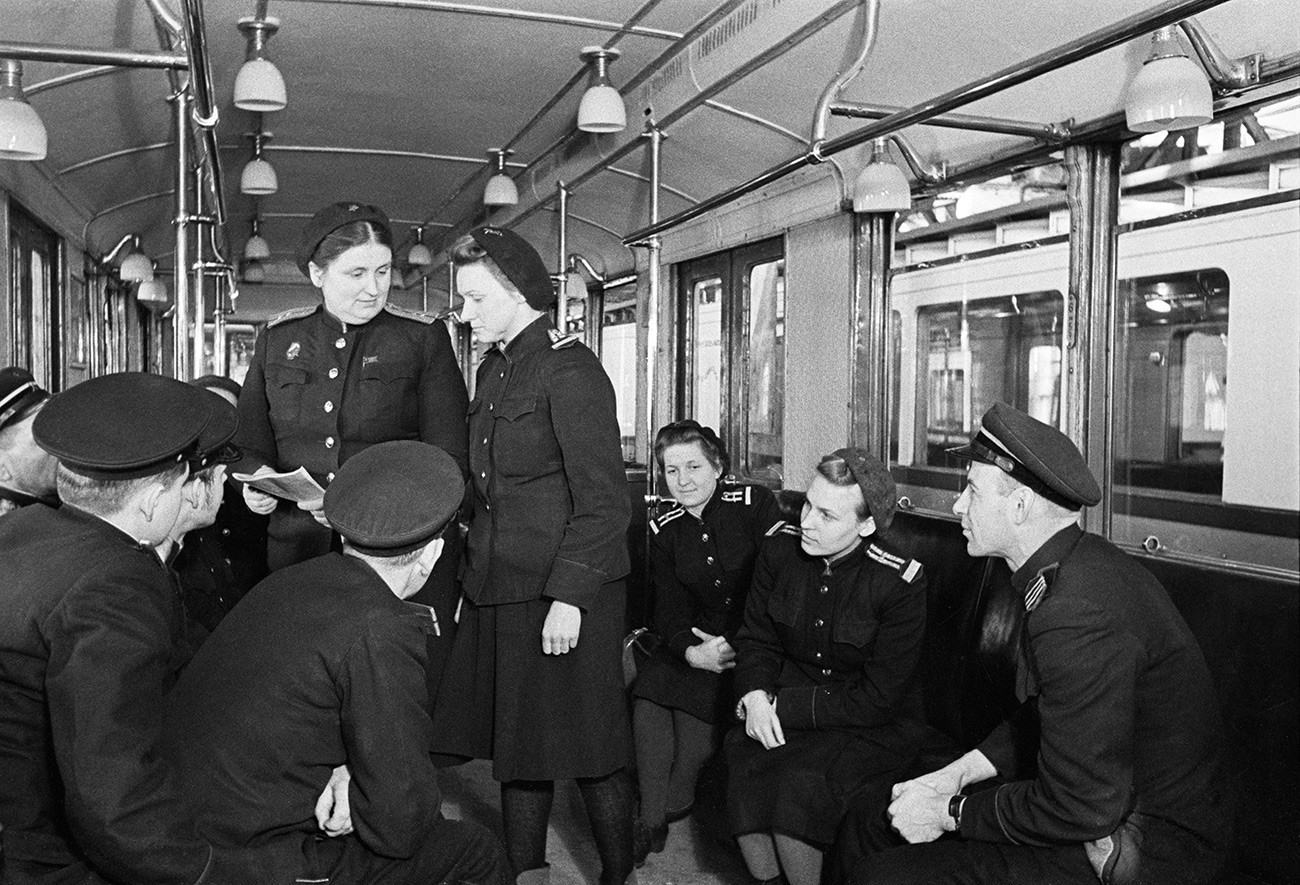
E. Mishina, standing, left, senior operator at the Severnoye maintenance facility of the Moscow Metro. 1949.
The city continued to build new stations and tracks despite the war. In 1943, a tunnel was laid under the Moskva River from Teatralnaya to Avtozavodskaya, and then from Kurskaya to Izmailovsky Park in 1944. Seven Moscow Metro stations have commemorative plaques reading: “Built in the days of World War II.”
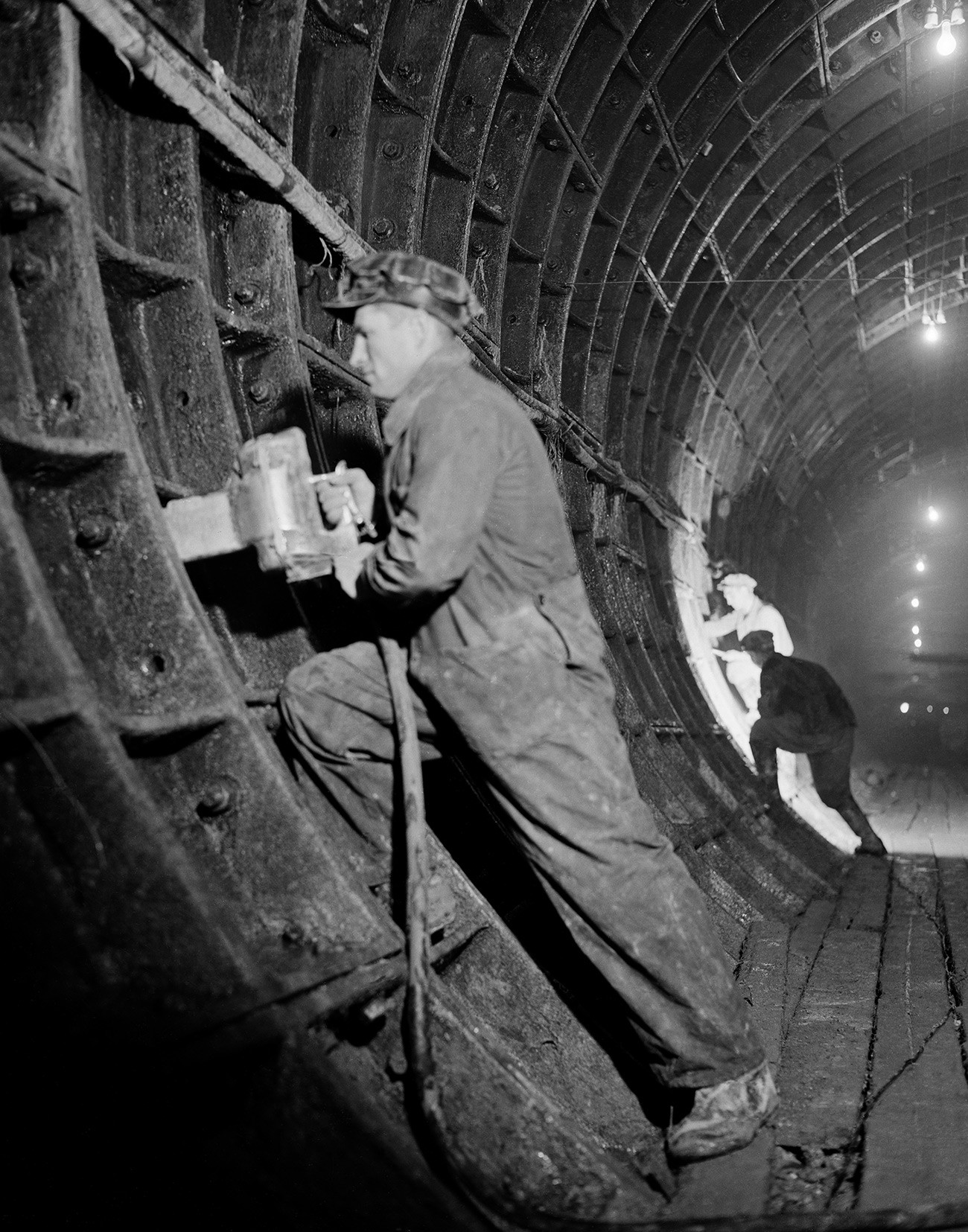
Building the Arbatsko-Pokrovskaya metro line in Moscow, 1944.
If using any of Russia Beyond's content, partly or in full, always provide an active hyperlink to the original material.
to our newsletter!
Get the week's best stories straight to your inbox
- 13 photos showing the heart and soul of Moscow metro daily routine
- Why this Ethiopian navy officer ended up as a metro driver
- Why is the Moscow Metro so fast and efficient?
This website uses cookies. Click here to find out more.
A Brief History of the Moscow Metro

There are many things for which Moscow is famous, and the metro is certainly one of the most prominent of them. The metro is the city’s beating heart. During peak hours, crowds of people pour out into the streets to the rhythm of the trains entering and leaving the stations. The metro is Moscow’s primary means of public transport; it’s also a monument to its turbulent history and vibrant present, and a crucial element and major constituent of its identity. You can’t understand Moscow without understanding its metro – this is why we’re introducing its brief history to you here.
Moscow’s metro is the most crowded in the world..
Moscow metro serves the largest number of passengers a day out of all the metro systems in the world : on weekdays this number goes up to nine million. It consists of 14 lines and 212 stations and has more than 360 km of tracks. Plus, 44 of these stations are cultural monuments. Why is that the case? And how did it all start?


It all started with Stalin.

What happened to the metro during the wars?
The Second World War had an influence on everything that happened in the country. The construction of the metro was no exception. Pro-socialist interior motifs were replaced with war-themed décor, the construction of new stations was delayed, and some of the old stations went out of service. Many of the stations served as air-raid shelters during the siege of Moscow in 1941. After the war, construction picked up again. The most iconic of the lines, the ring line, was opened. It traces the Garden Circle (one of the main avenues of the city). The ring makes changing lines wonderfully easy. It is marked brown in all the official metro plans. Rumour has it that it was never a part of the initial design, but that Stalin put a coffee mug on the provisional plans that left a mark in the shape and location of the current ring line, and that it was then constructed because nobody then dared to oppose the Leader’s note. The Cold War brought with it a reduction in both the metro’s budget and extravagance. The Cold War stations , located a little bit further from the centre, can be recognised immediately: they all look almost the same, with a row of columns running on both sides of the platform. The only difference between them is the colour of the marble or ceramic tiles on the walls.

Become a Culture Tripper!
Sign up to our newsletter to save up to 500$ on our unique trips..
See privacy policy .

What is happening with the metro now?
Nowadays, the Moscow metro is constantly expanding, with new stations added to the lines every year. 2016 was especially important in the life of the metro: it is when the second (on-land) circle line was open. The Moscow metro is also an important element of culture: one of the most popular contemporary Russian writers, Dmitri Glukhovsky , set his post-apocalyptic novels entirely in the metro. The metro is, figuratively and literally, the heart of Moscow. If you want to truly get to know the city, start from the metro.

KEEN TO EXPLORE THE WORLD?
Connect with like-minded people on our premium trips curated by local insiders and with care for the world
Since you are here, we would like to share our vision for the future of travel - and the direction Culture Trip is moving in.
Culture Trip launched in 2011 with a simple yet passionate mission: to inspire people to go beyond their boundaries and experience what makes a place, its people and its culture special and meaningful — and this is still in our DNA today. We are proud that, for more than a decade, millions like you have trusted our award-winning recommendations by people who deeply understand what makes certain places and communities so special.
Increasingly we believe the world needs more meaningful, real-life connections between curious travellers keen to explore the world in a more responsible way. That is why we have intensively curated a collection of premium small-group trips as an invitation to meet and connect with new, like-minded people for once-in-a-lifetime experiences in three categories: Culture Trips, Rail Trips and Private Trips. Our Trips are suitable for both solo travelers, couples and friends who want to explore the world together.
Culture Trips are deeply immersive 5 to 16 days itineraries, that combine authentic local experiences, exciting activities and 4-5* accommodation to look forward to at the end of each day. Our Rail Trips are our most planet-friendly itineraries that invite you to take the scenic route, relax whilst getting under the skin of a destination. Our Private Trips are fully tailored itineraries, curated by our Travel Experts specifically for you, your friends or your family.
We know that many of you worry about the environmental impact of travel and are looking for ways of expanding horizons in ways that do minimal harm - and may even bring benefits. We are committed to go as far as possible in curating our trips with care for the planet. That is why all of our trips are flightless in destination, fully carbon offset - and we have ambitious plans to be net zero in the very near future.

A Guide to Cautionary Russian Proverbs and What They Mean

The Soviet Union’s Best Heart-Throbs and Pinups

Guides & Tips
A 48 hour guide to astrakhan, russia.

Zhenotdel: The Soviet Union's Feminist Movement

Unusual Facts About the Soviet Union

A Soviet Pilot Went Missing in Afghanistan and Was Found 30 Years Later

Food & Drink
The best halal restaurants in kazan.

Russian Last Names and Their Meanings

The Mystery Behind Russia's Buddhist "Miracle"

Incredible Photos From the Longest Bike Race in the World

See & Do
Russia's most remote holiday destinations.

Restaurants
The best halal restaurants in kaliningrad, winter sale offers on our trips, incredible savings.

- Post ID: 96027
- Sponsored? No
- View Payload
- ALL MOSCOW TOURS
- Getting Russian Visa
- Top 10 Reasons To Go
- Things To Do In Moscow
- Sheremetyevo Airport
- Domodedovo Airport
- Vnukovo Airport
- Airports Transfer
- Layover in Moscow
- Best Moscow Hotels
- Best Moscow Hostels
- Art in Moscow
- Moscow Theatres
- Moscow Parks
- Free Attractions
- Walking Routes
- Sports in Moscow
- Shopping in Moscow
- The Moscow Metro
- Moscow Public Transport
- Taxi in Moscow
- Driving in Moscow
- Moscow Maps & Traffic
- Facts about Moscow – City Factsheet
- Expat Communities
- Groceries in Moscow
- Healthcare in Moscow
- Blogs about Moscow
- Flat Rentals
The Moscow Metro – MCC – MCD – everything about capital’s subway
Moscow Metro map and journey planner app called Yandex.Metro is available for iOS and Android for free.
We have a great Moscow Metro & Stalin Skyscrapers Private Tour across all famous metro stations, available for you every day.
1. Famous Moscow metro stations
Kievskaya (circle line).

The station was opened on March 14, 1954. It was named after the nearby Kievsky Railway Station. Decorating of station is devoted to friendship of Russian and Ukrainian people. Rich mosaic decoration is made from smalt and valuable stones by project of Ukrainian architects, chosen from seventy-three works presented on competition.
Kievskaya (Dark-blue line)
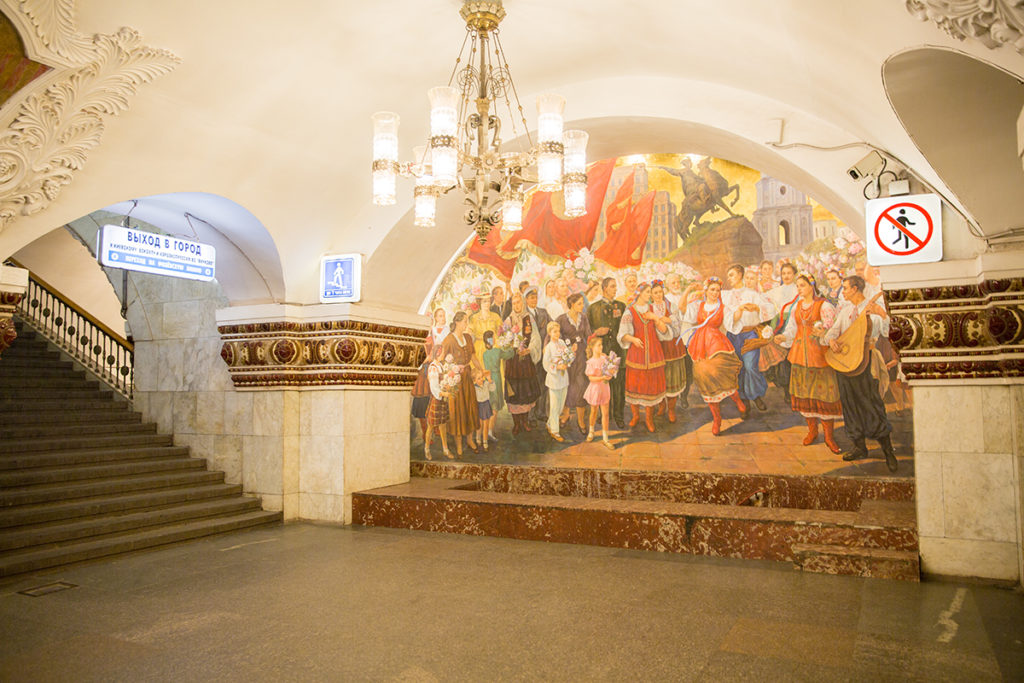
It was opened on April 5, 1953. Design of the station is devoted to the Soviet Ukraine and reunion of Ukraine and Russia. The station is decorated with a large number of the picturesque cloths executed in style of socialist realism in fresco technique. The fresco «Holiday in Kiev», made in 1953 was practically destroyed in 2010, due to an accident during nearby constructing works. While the fresco recovery, restorers revived its original appearance that had gone through many changes since its creation.
Ploshad Revolutsii

The station was opened on March 13, 1938. The most interesting feature of the station is 76 bronze figures, situated in niches of 18 arches. This peculiar gallery of images of Soviet people, aimed to personify force and power of the country, its glorious past and bright future. One of the bronze sculptures — a dog that accompanies a frontier guard — is believed to bring good luck if you touch its nose.
Prospekt Mira

Prospect Mira station of the Circle line was opened on January 30, 1952. It used to be called Botanical Garden up to June 20, 1966. The station’s decoration is devoted to development of agriculture in the USSR. Light marble and bas-reliefs by sculptor G. I. Motovilov decorate poles of the station. Famous smalt panel «Mothers of the World» by A. N. Kuznetsov is situated in the lobby.
Komsomolskaya

Komsomolskaya station was opened on January 30, 1952. The station has rich decoration devoted to a fight of USSR against overseas aggressors and victory in the Great Patriotic War. Mosaic panels from smalt and valuable stones, created according to sketches of the Lenin Award winner Pavel Corin, represent famous Russian commanders and weapons of different eras.
Novokuznetskaya

The station was opened on November 20, 1943. Its name was originally written through a hyphen: ‘Novo-Kuznetskaya’. The interior of the station is rich with decorating elements. The idea of creative force and power of Soviet people, its remarkable victories in the Great Patriotic War found realization in architectural design of station. The perimeter of the escalator arch is decorated with bronze sculptures by the sculptor N.V.Tomsky.
Novoslobodskaya

Novoslobodskaya station was opened on January 30, 1952. It was called after Novoslobodskaya street, where the station is situated. 32 original stained-glass windows from multi-colored glass, framed with steel and gilded brass and the famous mosaic panel «World peace», situated at the face wall the station, are made by sketches of Pavel Dmitriyevich Corin.
Dostoyevskaya

Dostoevskaya is comparatively new station, opened on June 19, 2010. It is situated at Suvorovskaya Square. Russian writer Fedor Dostoyevsky was born and lived in this district of Moscow. Therefore, the station bears his name and features scenes from his works «Crime and Punishment», «The Idiot», «Demons», «The Brothers Karamazov». Artist Ivan Nikolaev, the author of the decoration, said that depicting scenes of violence shows depth and tragedy of Dostoevsky’s work.
2. General information about Moscow metro
Metro working hours, navigation, wi-fi.
The Moscow Metro is open from about 5:30 am until 1:00 am. The precise opening time varies at different stations according to the arrival of the first train, but all stations simultaneously close their entrances and transitions to other lines at 01:00 am for maintenance. The minimum interval between trains is 90 seconds during the morning and evening rush hours. Each line is identified according to an alphanumeric index (usually consisting of a number), a name and a color. Voice announcements in Russian refer to the lines by name and by numbers in English. A male voice announces the next station when traveling towards the center of the city or the clockwise direction on the circle line, and a female voice – when going away from the center or the counter-clockwise direction at the circle. The lines are also assigned specific colors for maps and signs.
Free Wi-Fi is called MT_FREE and available on all 14 lines (inside the trains).
Using Metro services is frequently the fastest and the most efficient way to get from one part of the city to another. But during daytime Moscow Metro stations are usually overcrowded so if you want to just enjoy the beauty of the underground, it’s better to visit it late in the evening.
MCC and MCD
Since 2016 The Moscow Metro is connected to two new types of rail transport. The first one is MCC – Moscow Central Circle. It has 31 stations around the city with changes to metro stations (most of them require to walk a few minutes via the street). The second one is MCD, Moscow Central Diameters, a system of city train services on existing commuter rail lines in Moscow and Moscow Oblast. MCD has several lines, they’re being marked as D1, D2 etc. Changing to both MCC and MCD from the Metro is free when your journey is within the city. Both MCC and MCD lines exist on all of the Moscow Metro maps.
Interesting facts about Moscow metro
213 people were born in the metro during the World War II, when it was used as a bomb shelter.
There are 76 bronze sculptures of workers, peasants, soldiers, sailors, etc. at Ploshchad Revolyutsii station. There is legend connected with this station. To pass any examination successfully, a student should touch the bronze dog’s nose («the Frontier Guard with a Dog» sculpture). You can easily understand high popularity of this legend by looking at the polished nose of the dog.
It is said that some of the magnificent mosaics at several central stations, for example the «World Peace» mosaic at Novoslobodskaya, were made with the pieces of enamel and smalt, taken from the famous Christ the Savior Cathedral, before it’s destruction.
As any other dungeon the Moscow metro, has its own ghosts. The most famous one is the old lineman. He is not dangerous and usually hides into the wall, when people appear. The ghostly metro train is much more dangerous. It appears after midnight at the Circle Line and consists of old-time carriages. It sometimes stops at the stations and opens its doors, and then goes back into the darkness. It is said that the souls of Stalin’s prisoners, perished during the building of the metro are locked in the train forever.
3. Moscow Metro tickets
1 or 2 trips.
You can buy tickets in ticket offices or in automatic ticket machines. Passes for 1 or 2 trips are the most expensive. They sold only in ATM and cost 55 and 110 rubles (€0.55 and €1.10) respectively.
More than 2 trips
All the other kinds of tickets are available in the ticket offices. Tickets for bigger amount of trips are more profitable.
«90 Minutes» ticket
A ticket «90 minutes» is valid for one trip on the metro and an unlimited number of trips on surface transport within this time. It costs 65 rub (€0.65).
The «Troyka» card
You can also use «Troyka» – refillable card to pay for travelling on all kinds of public transport – metro, buses, trolley-buses, trams, monorail and blue minibuses. With «Troyka» one trip costs 35 rub (€0.35).

PLAN YOUR TRIP WITH US

Happy to help you with everything, from general plan of your visit to plane tickets or hotel stay. We may also support your Russian Visa request with a letter of invitation if you need so.
SEE OUR TOURS

We host around 60 tours every month in English, Russian, German, Italian, Spanish, Arabic and other languages. All of our tours =>
SAVE THIS LINK

If you only started to think about visiting Moscow, just save our site in your browser’s bookmarks or follow us on Facebook and Instagram to be in touch.
Tour Guide Jobs →
Every year we host more and more private tours in English, Russian and other languages for travelers from all over the world. They need best service, amazing stories and deep history knowledge. If you want to become our guide, please write us.
Contact Info
+7 495 166-72-69
119019 Moscow, Russia, Filippovskiy per. 7, 1
Mon - Sun 10.00 - 18.00
©Copyright Mandy Barrow 2013 primaryhomeworkhelp.com
Follow me on Twitter @mbarrow
Woodlands Junior School, Hunt Road Tonbridge Kent TN10 4BB UK

IMAGES
VIDEO
COMMENTS
By the autumn of 1940 the government realised that air-raid shelters on the surface did not offer very good protection from high explosive bombs. Deeper shelters were used. Caves were used in many parts of Britain. On September 21, 1940 the London Underground started to be used as an air raid shelter. On the busiest night in 1940, 177,000 ...
Alan lived in north London during World War Two and was in his home when the neighbour's house suffered a direct hit. Alan lost his mother in the bombing. Alan revisits his home and school, where ...
Homework. Student activity. Worksheet. Why did people need air raid shelters? What were they made out of? Children read and discuss facts about World War Two air raid shelters. Can they plan and build their own amazing model shelter? An excellent cross-curricular Design and technology activity. 114 KB.
This fab PowerPoint has everything you'll need to effectively teach about WW2 air raid shelters to KS2 students. It covers some context about the air raids and why shelters were necessary, with a recording of the air raid siren to play to your pupils. This can help the kids imagine what it must have been like, making for some really vivid and ...
In September 1935, four years before WW2 began, British prime minister, Stanley Baldwin, published a circular entitled Air Raid Precautions (ARP) inviting local authorities to make plans to protect their people in event of a war. Such plans included building public air raid shelters. In April 1937 the government decided to create an Air Raid ...
These shelters were to be constructed by private builders (under the supervision of Government inspectors and surveyors). The shelters were built with thick brick walls and a reinforced concrete roof. They could house about 50 people. Many street communal shelters were built. Unfortunately, the shelters didn't perform very well in air raids.
File previews. pptx, 1.65 MB. pptx, 259.28 KB. This lesson looks into different types of shelters used during the Blitz during WW2. It has handy QR code links to information sheets for students. Students are then tasked with designing their own shelter based on the types of shelters which were used during WW2.
Loads of information to help kids learn about World War 2 that is easy to read : Information about World War 2: ... People carried gas masks to protect themselves and built air raid shelters shelters. All windows and doors were blacked out. Timeline: Air Raid Shelters: ... All the materials on these pages are free for homework and classroom use ...
If outside, find a communal shelter. The Tube, October 1940, by Feliks Topolski (wash on paper) The government initially tried to prevent London Underground stations being used as air raid shelters, fearing the development of a 'deep shelter mentality' and the potential disruption of the capital's transport network.
The oldest surviving air-raid shelter in Britain is a little grey garage behind a house in Cleethorpes, Lincolnshire. After Zeppelin attacks killed a number of residents and soldiers in April 1916, Joseph Forrester, a chemist and local councillor, constructed a reinforced concrete air-raid shelter with walls half a metre thick.
Make a model of an air raid shelter / Anderson shelter. Think about which materials would be best to use. Draw and label an aeroplane from WWII e.g. British Spitfire. Written Task - Choose ONE of the following tasks: (If you are writing by hand please complete straight into your h/w book.) Interview a family member/friend about their
This engaging Design an Air Raid Shelter Activity is ideal for making cross-curricular links during a topic about the Second World War and the Blitz. Children can design and label their own air raid shelter, thinking critically about how to ensure it can keep people safe and protected. They should also consider which materials would be needed ...
Anderson worked with an engineer called William Patterson to design and ball a small, inexpensive air raid shelter that people could build in their garden. The first Anderson shelter was built in 1939. It was built in a garden in Islington, London on February 25, 1939. Over 1.5 million Anderson shelters were given out before the start of WW2.
The shelter had a seating capacity for 9,000 people. At the end of the war most of the fittings were removed and all but one of the entrances that had been made into the tunnel were bricked up ...
The British evacuation began on Friday 1 September 1939. It was called 'Operation Pied Piper'. Between 1939 - 1945 there were three major evacuations in preparation of the German Luftwaffe bombing Britain. The first official evacuations began on September 1 1939, two days before the declaration of war. By January 1940 almost 60% had returned to ...
Moscow has preserved many of its memories of World War II. They include the June 1941 mobilization, the endless air raids and evacuation, the enemy's withdrawal and the return of the soldiers ...
A table for comparing Anderson shelters, Morrison shelters and Public shelters like London Underground stations. A great task to set for homework (research can easily be done on the Primary Homework Help page on WW2 shelters).
Vasily Malyshev/TASS. During the war, the metro worked until 10:00 p.m. and then functioned as a shelter until 5:00 a.m. In the event of an air raid, trains stopped running immediately and metro ...
Primary Homework Help. Britain Since the 1930s. by Mandy Barrow ... Shelters: Slogans: Soldiers: Wartime Songs: Timeline: Wardens: Websites: Women: VE and VJ Days: World War Two 1939 - 1945. Remembrance Day. For almost six years from 1939 to 1945 Britain fought the toughest war it had ever experienced. World War II was total war - every person ...
Many of the stations served as air-raid shelters during the siege of Moscow in 1941. After the war, construction picked up again. The most iconic of the lines, the ring line, was opened. It traces the Garden Circle (one of the main avenues of the city). The ring makes changing lines wonderfully easy. It is marked brown in all the official metro ...
MCC and MCD. Since 2016 The Moscow Metro is connected to two new types of rail transport. The first one is MCC - Moscow Central Circle. It has 31 stations around the city with changes to metro stations (most of them require to walk a few minutes via the street). The second one is MCD, Moscow Central Diameters, a system of city train services ...
An air raid siren will play automatically on this page. It was dangerous living in a big city during the war. Cities were the target of enemy aircraft that flew over at night and dropped bombs. At 4:56pm on 7 September 1940, the air raid sirens wailed as the German Air Force, the luftwaffe, launched a massive raid on London.
People had to take precautions against any bombs dropped during air raids and the possibility of the Germans invading Britain. Children and some women were evacuated from the big cities into the countryside. People carried gas masks to protect themselves and built air raid shelters shelters. All windows and doors were blacked out.